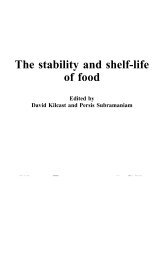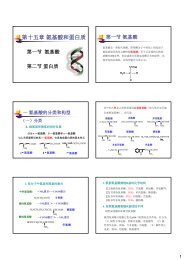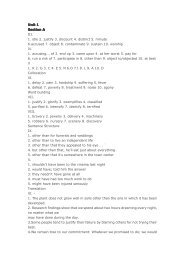Author's personal copy
Author's personal copy
Author's personal copy
You also want an ePaper? Increase the reach of your titles
YUMPU automatically turns print PDFs into web optimized ePapers that Google loves.
This article appeared in a journal published by Elsevier. The attached<br />
<strong>copy</strong> is furnished to the author for internal non-commercial research<br />
and education use, including for instruction at the authors institution<br />
and sharing with colleagues.<br />
Other uses, including reproduction and distribution, or selling or<br />
licensing copies, or posting to <strong>personal</strong>, institutional or third party<br />
websites are prohibited.<br />
In most cases authors are permitted to post their version of the<br />
article (e.g. in Word or Tex form) to their <strong>personal</strong> website or<br />
institutional repository. Authors requiring further information<br />
regarding Elsevier’s archiving and manuscript policies are<br />
encouraged to visit:<br />
http://www.elsevier.com/<strong>copy</strong>right
<strong>Author's</strong> <strong>personal</strong> <strong>copy</strong><br />
Biochemical Systematics and Ecology 38 (2010) 981–987<br />
Contents lists available at ScienceDirect<br />
Biochemical Systematics and Ecology<br />
journal homepage: www.elsevier.com/locate/biochemsyseco<br />
Molecular cloning, expression pattern and phylogenetic analysis of<br />
myosin light chain 2 gene from Antheraea pernyi: A potential marker<br />
for phylogenetic inference<br />
Lin Liu a,1 , Hui-Ying Wang a,1 , Hong-Yu Jin a,1 , Song Wu a , Yu-Ping Li a , Yan-Qun Liu a,b, *,<br />
Xi-Sheng Li b , Li Qin a , Zhen-Dong Wang a<br />
a Department of Sericulture, College of Bioscience and Biotechnology, Shenyang Agricultural University, Liaoning, Shenyang 110866, China<br />
b Sericultural Institute of Liaoning Province, Fengcheng 118100, China<br />
article<br />
info<br />
abstract<br />
Article history:<br />
Received 14 May 2010<br />
Accepted 14 September 2010<br />
Available online 8 October 2010<br />
Keywords:<br />
Antheraea pernyi<br />
Myosin light chain 2<br />
Gene cloning<br />
Expression pattern<br />
Phylogeny<br />
Myosin light chain 2 (MLC-2) gene was isolated and characterized from Antheraea pernyi,<br />
a well-known wild silkmoth. The isolated cDNA sequence is 905 bp in length with an open<br />
reading frame of 612 bp encoding a polypeptide of 203 amino acids. Semi-quantitative<br />
RT-PCR analysis showed that the MLC-2 gene was transcribed during four developmental<br />
stages (egg, larva, pupa, and moth), and present in all tissues tested. Alignment analysis<br />
revealed that the deduced protein sequence has over 95% identity to myosin light chain 2<br />
of lepidopteran species, and 57–88% identity to other insect species, suggesting that insect<br />
MLC-2 proteins are highly conserved throughout evolution. The protein sequence was used<br />
to construct phylogenetic trees with other known vertebrate and invertebrate MLC-2<br />
sequences, and the obtained trees demonstrated similar topology with the classical<br />
systematics, indicating the potential value of MLC-2 gene in phylogenetic study.<br />
Ó 2010 Elsevier Ltd. All rights reserved.<br />
1. Introduction<br />
Myosins are eukaryotic actin-dependent molecular motors important for a broad range of functions like muscle<br />
contraction, vision, hearing, cell motility, and host cell invasion of apicomplexan parasites (Foth et al., 2006). The past decade<br />
has seen a significant increase in research on myosins, which have been identified in a wide variety of eukaryotic organisms.<br />
Conventional myosin is built as homodimers of heavy chains each of which binds one essential light chain and one regulatory<br />
light chain (Geeves and Holmes, 2005). The regulatory light chain binds competitively with Mg 2þ or Ca 2þ ions and undergoes<br />
phosphorylation by myosin light chain kinase (Nieznanski et al., 2003). There is compelling evidence that binding of Ca 2þ to<br />
regulatory light chain may have a modulatory effect. Traditionally, myosin regulatory light chain, also known as myosin light<br />
chain 2 (MLC-2), is known to regulate the construction of muscles. In Drosophila, myosin light chain 2 mutation can affect<br />
flight, wing beat frequency, and indirect flight muscle contraction kinetics (Warmke et al., 1992). Recently, it has been<br />
reported that myosin light chain may be a candidate gene of insecticide resistance in Culex pipiens pallens (Yang et al., 2008)<br />
and a novel allergen in shrimp Litopenaeus vannamei (Ayuso et al., 2008).<br />
* Corresponding author. Department of Sericulture, College of Bioscience and Biotechnology, Shenyang Agricultural University, No. 120 Dongling Road,<br />
Shenyang 110866, China. Tel.: þ86 24 88487163; fax: þ86 24 88492799.<br />
E-mail address: liuyanqun@syau.edu.cn (Y.-Q. Liu).<br />
1 These authors contributed equally to this work.<br />
0305-1978/$ – see front matter Ó 2010 Elsevier Ltd. All rights reserved.<br />
doi:10.1016/j.bse.2010.09.006
<strong>Author's</strong> <strong>personal</strong> <strong>copy</strong><br />
982<br />
L. Liu et al. / Biochemical Systematics and Ecology 38 (2010) 981–987<br />
Antheraea pernyi (Lepidoptera: Saturniidae), is an economically important insect species. This insect is known to be<br />
domesticated in China around the 16th century (Zhang, 1982), and it is commercially cultivated for wild silkworm silk<br />
production. The silkworm, including larva, pupa and moth, is also used for a high quality protein food (Zhou and Han, 2006).<br />
Moreover, it has become an excellent natural bioreactor for the production of recombinant proteins (Huang et al., 2002). We<br />
have constructed a full-length cDNA library from A. pernyi pupa (Li et al., 2009) and performed the Expressed Sequence Tags<br />
(EST) sequencing to identify the functional genes of this species. Using this strategy, a lysophospholipase gene a constitutively<br />
expressed actin gene of this species have been cloned and characterized (Liu et al., 2010; Wu et al., 2010).<br />
It has been reported that myosin heavy chain type II gene sequence is a new molecular tool for phylogenetic inference in<br />
Bilateria, as that previously obtained by SSU and Hox sequences (Ruiz-Trillo et al., 2002). Phylogenetic trees based on the<br />
MLC-2 protein sequences accurately group the known vertebrate and invertebrate sequences (Yang et al., 2008; Xu et al.,<br />
2009). The MLC-2 has been cloned from various insect species such as Drosophila melanogaster (Parker et al., 1985), Lonomia<br />
oblique (Veiga et al., 2005), Tribolium castaneum (Richards et al., 2008), Bombyx mandarina (Xu et al., 2009), but the MLC-2<br />
gene sequence from A. pernyi has not been reported to date.<br />
In this paper, we describe the cloning and characterization of MLC-2 gene from A. pernyi. The expression patterns at<br />
various developmental stages and in different tissues in fifth-instar larvae were investigated. Finally, the deduced protein<br />
sequence of the MLC-2 gene from A. pernyi and other organisms were used to examine the relationship among these species,<br />
and to test the potential use of this gene in phylogenetic study.<br />
2. Materials and methods<br />
2.1. Insects and tissues<br />
Antheraea pernyi strain Shenhuang No.1 was used in this study, which was reared on oak (Quercus liaotungensis) trees in the<br />
field. Eggs at day 5, fifth-instar larvae, pupae and moths were stored at 80 C for later use. Blood, fat body, midgut, silk<br />
glands, body wall, Malpighian tubules, spermaries, ovaries, brain and muscle were dissected from silkworm larvae at day 10 of<br />
the fifth-instar and also stored at 80 C.<br />
2.2. Isolation of the A. pernyi MLC-2 gene and sequence analysis<br />
A full-length A. pernyi pupal cDNA library was constructed in our laboratory (Li et al., 2009). An EST encoding the MLC-2<br />
gene (GenBank accession no. GH3349806) was isolated. So, the cDNA clone was used to complete the full-length cDNA<br />
sequence of the MLC-2 gene. DNA sequences generated were assembled and edited to obtain a consensus sequence. DNASTAR<br />
software (DNASTAR Inc., Madison, Wisconsin, USA) was used to identify open reading frame (ORF), deduce amino acid<br />
sequence, and predict isoelectric point and molecular weight of the deduced amino acid sequence. Blast search was performed<br />
at http://www.ncbi.nlm.nih.gov/blast.cgi. The functional domain was predicted by software SMART (http://smart.<br />
embl-heidelberg.de/). The signal peptide and cellular localization was predicted by software Signal IP 3.0 (http://www.cbs.<br />
dtu.dk/services/SignalP/) and PSORT (http://psort.nibb.ac.jp/form2.html). The in silico gene expression analysis was<br />
employed at http://silkworm.swu.edu.cn/silkDB based on the extensive microarray information.<br />
2.3. Total RNA extraction and first strand cDNA synthesis<br />
Total RNA was extracted from A. pernyi samples using RNAsimple Total RNA Extraction Kit (TIANGEN Biotech Co. Ltd.,<br />
Beijing) according to the manufacturer’s instructions. DNase I was used to remove contaminating genomic DNA. The purity<br />
and quantity of extracted RNA was quantified by the ratio of OD 260 /OD 280 with an ultraviolet spectrometer. Using 2 mg of total<br />
RNA per sample, first strand cDNA was generated with TIANScript cDNA Synthesize Kit (TIANGEN Biotech Co. Ltd., Beijing)<br />
following the manufacturer’s instructions.<br />
2.4. Semi-quantitative RT-PCR analyses<br />
The cDNA samples were amplified by semi-quantitative PCR method using the gene-specific primer pair LYQ129 (5 0 -<br />
TGGCGGATAAGGATAAGAAA -3 0 ) and LYQ130 (5 0 - GTCAACAGCTGGGTGAAGTT -3 0 ) for the MLC-2 gene, which generated<br />
a 346 bp fragment. A constitutively expressed actin gene (GenBank accession no. GU073316) (Wu et al., 2010) was used as the<br />
internal control with the gene-specific primer pair LYQ85 (5 0 CCAAA GGCCA ACAGA GAGAA GA 3 0 ) and LYQ86 (5 0 CAAGA<br />
ATGAG GGCTG GAAGA GA 3 0 ), which generated a 468 bp fragment. PCR amplification was carried out in a total reaction<br />
volume of 25 ml, containing normalized cDNA, 20 pmol of each primer, 2 mM MgCl 2 , 0.25 mM dNTP, 1 buffer and 2.5 U Taq<br />
DNA polymerase (TIANGEN Biotech Co. Ltd., Beijing). PCRs were performed with the following cycles: initial denaturation at<br />
95 C for 5 min; followed by 25 cycles of 1 min at 95 C, 30 s annealing at 55 C, 30 s extension at 72 C; and a final extension at<br />
72 C for 10 min. The amplification products were analyzed on 1.0% agarose gels stained with ethidium bromide. To avoid<br />
sample DNA contamination, the negative RT-PCRs control reactions were performed with every total RNA as templates. To<br />
confirm the specificity of RT-PCR amplification, the RT-PCR products were purified from the gel and sequenced.
<strong>Author's</strong> <strong>personal</strong> <strong>copy</strong><br />
L. Liu et al. / Biochemical Systematics and Ecology 38 (2010) 981–987 983<br />
2.5. Phylogenetic analysis<br />
Clustal X software (Thompson et al., 1997) was used to align amino acid sequences. A phylogenetic tree was constructed by<br />
MEGA version 4 (Tamura et al., 2007) using the Neighbour–Joining (NJ) method (Saitou and Nei, 1987). A Poisson-corrected<br />
distance was used, and the statistical significance of group in the NJ tree was assessed by the bootstrap probability with 500<br />
replications. Maximum Parsimony (MP) method was also used for phylogenetic reconstruction.<br />
3. Results<br />
3.1. Sequence analysis of the A. pernyi MLC-2 gene<br />
The full-length MLC-2 gene was isolated and identified from the A. pernyi pupal cDNA library (Li et al., 2009). The cDNA<br />
sequence and deduced amino acid sequence of the MLC-2 gene is shown in Fig. 1. The obtained 905 bp cDNA sequence<br />
contains a 5 0 -untranslated region (UTR) of 63 bp, a 3 0 UTR of 197 bp and a poly (A) tail of 33 bp, and an ORF of 612 bp encoding<br />
a polypeptide of 203 amino acids. However, no polyadenylation signal sequence AATAAA was found. Predicted protein<br />
sequences of this isolated cDNA shared 98% identity with the MLC protein from L. oblique (AAV91413) (Veiga et al., 2005). This<br />
cDNA sequence has been deposited in GenBank under accession no. HM182104.<br />
The deduced amino acid sequence has a predicted molecular weight of 22.3 kDa and isolectric point of 4.5. No signal<br />
peptide was found. Cellular localization analysis indicated that MLC-2 likely existed in the cytoplasm. Prediction of functional<br />
domain showed the A. pernyi MLC-2 protein contains two “EF-hand” frames. They were identified at position 61–89<br />
with the E-value of 1.34e-02 for the EF-hand domain and 165–193 with the E-value of 9.79eþ00 for the EF-hand domain,<br />
respectively. The full Ca 2þ binding site sequence (DHDKDGIIGKNDL) (Olsson and Sjölin, 2001) was found within the first<br />
“EF-hand” frame.<br />
3.2. Expression patterns at different developmental stages and in various tissues<br />
Semi-quantitative RT-PCR was employed to quantify the A. pernyi MLC-2 gene expression levels during different developmental<br />
stages and tissue distributions in fifth-instar larvae (Fig. 2). The result showed that the A. pernyi MLC-2 gene was<br />
expressed during four developmental stages including egg, larva, pupa and adult, indicating that its product plays an<br />
important role throughout the entire life cycle. The lowest mRNA level was found in egg stage. The negative control exhibited<br />
Fig. 1. The complete nucleotide and deduced amino acid sequence of myosin light chain 2 gene of A. pernyi. The deduced amino acid residue is represented by<br />
one-letter symbol. The initiation codon ATG bolded and the termination codon TAA bolded and marked with an asterisk. The two predicted“EF-hand”frames<br />
shaded. No polyadenylation signals AATAAA are detected. The nucleotide underlined shows the position of gene-specific primer used in the experiment. The<br />
cDNA sequence was deposited in GenBank under accession no. HM182104.
<strong>Author's</strong> <strong>personal</strong> <strong>copy</strong><br />
984<br />
L. Liu et al. / Biochemical Systematics and Ecology 38 (2010) 981–987<br />
Fig. 2. Expression patterns of the A. pernyi myosin light chain 2 gene. Both Electrophoretic results (A) and the relatively intensity (B) are shown. The expression<br />
patterns were analyzed by RT-PCR using gene-specific primer pair for the A. pernyi myosin light chain 2 gene. The actin gene was used as an internal standard.<br />
Horizontal line 1–4 represents the four developmental stages of eggs at day 5, fifth-instar larvae, pupae and moths, respectively; and 5–14 represents the ten<br />
tissues in the fifth-instar larvae including blood, fat body, midgut, silk glands, body wall, Malpighian tubules, spermaries, ovaries, brain and muscle, respectively.<br />
no products (data not shown). By sequencing, we confirmed that the positive e RT-PCR products were amplified from the<br />
MLC-2 gene sequence.<br />
The MLC-2 RNA was also found to be present in all tissues tested of fifth-instar larvae, including blood, midgut, silk glands,<br />
Malpighian tubules, spermaries, ovaries, brain, muscle, fat body and body wall. However, the mRNA levels showed a tissuespecific<br />
expression pattern, with the most abundance in muscle followed by body wall and the lowest in spermaries. Ovaries<br />
and spermaries are two reproductive organs derived from female and male silkworm, respectively. RT-PCR analysis revealed<br />
that the mRNA levels in ovaries were slightly higher than spermaries.<br />
3.3. Homologous alignment and phylogenetic analysis<br />
To assess the relatedness of the A. pernyi MLC-2 to its homolog from other organisms, identities were calculated based on<br />
a Clustal alignment including 31 MLC-2 protein sequences (Figs. 3 and 4). The putative amino acid sequence of the MLC-2<br />
gene from Spodoptera frugiperda (ButterflyBase accession no. SFC00155_3), which was not available at GenBank, was<br />
downloaded from ButterflyBase, an open-access Genomic Database for Lepidoptera (Papanicolaou et al., 2008). We used two<br />
MLC-2 sequences (AAA51466 and AAN14222, respectively)(Parker et al., 1985; Adams et al., 2000) as the representatives of<br />
Drosophila. InFig. 3, the sequence is shown aligned with various MLC-2 proteins of insect, including A. pernyi, L. oblique<br />
(AAV91413) (Veiga et al., 2005), S. frugiperda, Bombyx mori (ABF51421), B. mandarina (ABY50568) (Xu et al., 2009), Gryllotalpa<br />
orientalis (AAW22542), Apis mellifera (XP_393371), D. melanogaster (AAA51466), T. castaneum (EFA09644)(Richards et al.,<br />
2008), Acyrthosiphon pisum (DDBJ accession no. BAH70869). Protein sequence alignment revealed that the A. pernyi MLC-2<br />
protein had 98% identity to that of L. oblique, and about 95% identity to two Bombyx species and S. frugiperda, all of them<br />
belonging to Lepidoptera. The A. pernyi MLC-2 protein revealed 57–88% identity to other insect species, and 38–44% identity<br />
to other known vertebrate used in this study. Interestingly, the A. pernyi MLC-2 protein had only 37% identity to the nematode<br />
Caenorhabditis elegans (Q09510) (C. elegans Sequencing Consortium, 1998).<br />
An NJ tree was constructed using amino acid sequences (Fig. 4). The topology of tree reconstructed by the MP method is<br />
similar to the topology of NJ tree. Both NJ and MP analyses clearly separate the MLC-2 sequences of invertebrate species<br />
from those of vertebrate species. In phylogenetic tree, Saturniidae species (A. pernyi and L. oblique) and Bombycidae<br />
species (B. mori and B. mandarina) were clearly grouped into the separate clade with 86% of bootstrap support value. The<br />
MLC-2 genes of two hymenopteran species A. mellifera and Nasonia vitripennis were grouped together with 78% bootstrap<br />
support. The MLC-2 sequences from four mosquitos Anopheles gambiae, Aedes aegypti, C. pipiens pallens and Culex quinquefasciatus<br />
formed a clade with 100% bootstrap support. The MLC-2 genes of two flies D. melanogaster and Glossina<br />
morsitans morsitans formed a clade with 100% bootstrap support. The phylogenetic trees constructed in this study supported<br />
the monophyly of the Lipdoptera and the Diptera. The results were consistent with the traditional classification.<br />
Note that the nematode C. elegans was placed into the vertebrate group in this study, which was different with the<br />
traditional classification.
<strong>Author's</strong> <strong>personal</strong> <strong>copy</strong><br />
L. Liu et al. / Biochemical Systematics and Ecology 38 (2010) 981–987 985<br />
Fig. 3. Protein sequence alignment of myosin light chain 2 from A. pernyi and its homologs of insects. The conserved Ca 2þ binding site sequence was indicated by<br />
the number sign (#) above. Identity (%) in parentheses is obtained by pairwise alignment of amino acid sequence of A. pernyi myosin light chain 2 with the<br />
indicated homologs from other insects. Protein sequences of myosin light chain 2 were included from A. pernyi, Lonomia oblique (AAV91413), Spodoptera frugiperda<br />
(ButterflyBase accession no. SFC00155_3), Bombyx mori (ABF51421), Bombyx madarina (ABY50568), Gryllotalpa orientalis (AAW22542), Apis mellifera<br />
(XP_393371), Drosophila melanogaster (AAA51466), Tribolium castaneum (EFA09644) and Acyrthosiphon pisum (DDBJ accession no. BAH70869).<br />
4. Discussion<br />
Of the complete MLC-2 sequences available to date, only four are the lepidopteran sequences including L. oblique,<br />
S. frugiperda, B. mori and Bombyx mandarinai, although the order Lepidoptera is the second largest insect order and includes<br />
the most damaging agricultural pests and beneficial insects. In this study, the whole MLC gene from Antheraea perny was<br />
cloned and characterized. Translated amino acids alignment showed that it has over 95% similarity with myosin light chain 2<br />
of lepidopteran species, and 57% similarity with myosin light chain from D. melanogaster. Prediction of functional domain<br />
showed that it contained two “EF-hand” domains. It has been reported that “EF-hand” is conserved in mammals and insects<br />
(Aravind et al., 2008). These findings suggested that the gene we obtained was myosin light chain (MLC) of A. pernyi.<br />
RT-PCR analysis showed that the A. pernyi MLC-2 gene was found to be present in all tissues tested of fifth-instar larvae<br />
with a tissue-specific expression pattern: the most abundance in muscle followed by body wall and the lowest in spermaries.<br />
These results agreed well with those observed in B. mori, a lepidopteran model insect. Expression profiles based on the
<strong>Author's</strong> <strong>personal</strong> <strong>copy</strong><br />
986<br />
L. Liu et al. / Biochemical Systematics and Ecology 38 (2010) 981–987<br />
0.05<br />
99<br />
98<br />
90<br />
90<br />
91<br />
54<br />
78<br />
97<br />
99<br />
60<br />
100<br />
56<br />
86<br />
66<br />
97<br />
100<br />
Culex quinquefasciatus EDS45595<br />
Culex pipiens pallens AAZ67334<br />
Aedes aegypti EAT46218<br />
Anopheles gambiae EAA00945<br />
Glossina morsitans morsitans ADD18730<br />
Drosophila melanogaster AAA51466<br />
100<br />
Drosophila melanogaster AAN14222<br />
Acyrthosiphon pisum BAH70869<br />
Apis mellifera XP_393371<br />
Nasonia vitripennis XP_001608247<br />
Tribolium castaneum EFA09644<br />
Pediculus humanus corporis EEB13212<br />
Gryllotalpa orientalis AAW22542<br />
Antheraea pernyi<br />
Lonomia obliqua AAV91413<br />
Spodoptera frugiperda SFC00155 3<br />
Bombyx mandarina ABY50568<br />
Bombyx mori ABF51421<br />
Litopenaeus vannamei ACC76803<br />
Scolopendra subspinipes ACI94901<br />
99 Salmo salar ACI69826<br />
98<br />
Sus scrofa P29269<br />
Caenorhabditis elegans Q09510<br />
Monodelphis domestica XP_001183537<br />
Esox lucius ACO13907<br />
Felis catus P41691<br />
95 Xenopus tropicalis AAI58546<br />
100 Xenopus laevis AAH78537<br />
91 Gallus gallus P02610<br />
91 Homo sapiens AAB91993<br />
Mus musculus P51667<br />
Invertebrate<br />
Vertebrate<br />
Fig. 4. Phylogenetic tree based on the amino acid sequence comparisons of myosin light chain 2 gene from various arthropods including A. pernyi. The numbers<br />
above the branch represent bootstrap percentages. The topology was tested using bootstrap analyses (500 replicates). Accession numbers of myosin light chain 2<br />
proteins are shown following the names of organisms.<br />
genome-wide microarray data available at the SilkDB (Duan et al., 2009) also indicated that the B. mori MLC-2 gene was<br />
widely expressed in the tissues including blood, midgut, Malpighian tublues, spermaries, ovaries, fat body, body wall, and silk<br />
glands. The B. mori MLC-2 mRNA level was also found to be higher in ovaries than spermaries. Interestingly, when compared<br />
to the mRNA levels in body wall, the A. pernyi MLC-2 mRNA levels in blood was basically the same; however, the B. mori MLC-2<br />
mRNA levels in blood was low. Further experiments need to be performed to have additional evidences to affirm this result.<br />
By sequence alignment, we found that the MLC sequences from L. oblique (AAV91413) and T. castaneum (EFA09644)<br />
contained longer 5 0 fragment compared to other known vertebrate and invertebrate MLC-2 sequences (Fig. 3 and data not<br />
shown). The former was predicted to be 372 amino acids in length derived from the isolated mRNA sequence (Veiga et al.,<br />
2005), and the latter was predicted to be 286 amino acids derived from the whole genome shotgun sequence (Richards<br />
et al., 2008). Besides the two MLC sequences, the length and the putative start codon position of the other known vertebrate<br />
and invertebrate MLC-2 sequences including A. pernyi, most of them resulted from the isolated mRNA sequence, were<br />
highly conserved. Moreover, the corresponding position sequences in the two MLC sequences from L. oblique and T. castaneum<br />
were highly identical to most of insect MLC-2 sequences. Note that the L. oblique MLC amino acid sequences at position 1–141<br />
showed only one amino acid variation compared to those at position 170–310. Consequently, we suggested that the start<br />
codon positions of the two MLC sequences needed to be investigated in the future.<br />
Sequence alignment revealed more than 57% amino sequence identity among these insect MLC-2 proteins available to<br />
date, which suggested that insect MLC-2 proteins are highly conserved during evolution. Moreover, the four amino acid<br />
residues involved in the Ca 2þ bind site were highly conserved in all available insect MLC-2 proteins, with the exception of D.<br />
melanogaster (AAN14222) in which the corresponding Ca 2þ bind site sequences was found to be deleted.<br />
Eukaryotic molecular evolution was often studied using small subunit rRNA (SSU-rRNA) (Sogin, 1991), 16S rRNA and 18S<br />
rRNA (Philippe and Germot, 2000), and mitochondrial DNA such as cytochrome b (Farias et al., 2001). Recently, many house<br />
keeping genes such as ribosomal protein genes (Shang et al., 2005; Hou et al., 2008), myosin heavy chain type II genes (Ruiz-<br />
Trillo et al., 2002), and enolase genes (Regier et al., 2009) have been reported to be a new molecular tool for phylogenetic<br />
inference. Our study showed that the phylogenetic analysis based on the MLC-2 amino acid sequences clearly separated the<br />
known vertebrate and invertebrate, as found in the previous studies (Yang et al., 2008; Xu et al., 2009). The obtained trees<br />
demonstrated similar topology with the classical systematics, indicating the potential value of MLC-2 gene in insect phylogenetic<br />
comparison.
<strong>Author's</strong> <strong>personal</strong> <strong>copy</strong><br />
L. Liu et al. / Biochemical Systematics and Ecology 38 (2010) 981–987 987<br />
In summary, the MLC-2 gene from A. perny was cloned and characterized, which is the fifth sequence of Lepidopteran<br />
insect. We found that the MLC-2 gene is expressed during four developmental stages and in all test tissues, suggesting that it<br />
plays an important role in development of A. pernyi. Homologous alignment suggested that insect MLC-2 proteins are highly<br />
conserved throughout evolution. Phylogenetic analysis suggested that MLC-2 may be used as a potential marker in insect<br />
phylogenetic study.<br />
Acknowledgements<br />
This work was supported by grants from the National Modern Agriculture Industry Technology System Construction<br />
Project (Silkworm and Mulberry), the Scientific Research Project for High School of the Educational Department of Liaoning<br />
Province (No. 2008643), and the Student’s Science and Technology Innovation Project of Shenyang Agricultural University<br />
(No. 2009023).<br />
References<br />
Adams, M.D., Celniker, S.E., Holt, R.A., Evans, C.A., Gocayne, J.D., Amanatides, P.G., Scherer, S.E., Li, P.W., Hoskins, R.A., Galle, R.F., et al., 2000. The genome<br />
sequence of Drosophila melanogaster. Science 287, 2185–2195.<br />
Aravind, P., Chandra, K., Reddy, P.P., Jeromin, A., Chary, K.V., Sharma, Y., 2008. Regulatory and structural EF-hand motifs of neuronal calciumsensor-1: Mg 2þ<br />
modulates Ca 2þ binding, Ca 2þ -induced conformational changes, and equilibrium unfolding transitions. J. Mol. Biol. 376, 1100–1115.<br />
Ayuso, R., Grishina, G., Bardina, L., Carrillo, T., Blanco, C., Ibanez, M.D., Sampson, H.A., Beyer, K., 2008. Myosin light chain is a novel shrimp allergen, Lit v 3.<br />
J. Allergy Clin. Immunol. 122, 795–802.<br />
C. elegans Sequencing Consortium, 1998. Genome sequence of the nematode C. elegans: a platform for investigating biology. Science 282 (5396), 2012–2018.<br />
Duan, J., Li, R.Q., Cheng, D.J., Fan, W., Zha, X.F., Cheng, T.C., Wu, Y.Q., Wang, J., Mita, K., Xiang, Z.H., Xia, Q.Y., 2009. SilkDB v2.0: a platform for silkworm<br />
(Bombyx mori) genome biology. Nucleic Acids Res., 1–4.<br />
Farias, I.P., Ortl, G., Sampaio, I., Schneider, H., Meyer, A., 2001. The cytochrome b gene as a phylogenetic marker: the limits of resolution for analyzing<br />
relationships among cichlid fishes. J. Mol. Evol. 53, 89–103.<br />
Foth, B.J., Goedecke, M.C., Soldati, D., 2006. New insights into myosin evolution and classification. PNAS 103, 3681–3686.<br />
Geeves, M.A., Holmes, K.C., 2005. The molecular mechanism of muscle contraction. Adv. Protein Chem. 71, 161–193.<br />
Hou, W.R., Sun, G.L., Chen, Y., Wu, X., Peng, Z.S., Zhou, C.Q., 2008. Molecular cloning of ribosomal protein L26 (RPL26) cDNA from Ailuropoda melanoleuca and<br />
its potential value in phylogenetic study. Biochem. System. Ecol. 36, 194–200.<br />
Huang, Y.J., Kobayashi, J., Yoshimura, T., 2002. Genome mapping and gene analysis of Antheraea pernyi nucleopolyhedrovirus for improvement of baculovirus<br />
expression vector system. J. Biosci. Bioeng. 93, 183–191.<br />
Li, Y.P., Xia, R.X., Wang, H., Li, X.S., Liu, Y.Q., Wei, Z.J., Lu, C., Xiang, Z.H., 2009. Construction of a full-length cDNA library from Chinese oak silkworm pupa and<br />
identification of a KK-42 binding protein gene in relation to pupal-diapause termination. Int. J. Biol. Sci. 5, 451–457.<br />
Liu, Y.Q., Li, Y.P., Wu, S., Xia, R.X., Shi, S.L., Qin, L., Lu, C., Xiang, Z.H., 2010. Molecular cloning and expression pattern of a lysophospholipase gene from<br />
Chinese oak silkworm, Antheraea pernyi. Ann. Entomol. Soc. Am. 103, 647–653.<br />
Nieznanski, K., Nieznanska, H., Skowronek, K., Kasprzak, A.A., Stepkowski, D., 2003. Ca 2þ binding to myosin regulatory light chain affects the conformation<br />
of the N-terminus of essential light chain and its binding to actin. Arch. Biochem. Biophys. 417, 153–158.<br />
Olsson, L.L., Sjölin, L., 2001. Structure of Escherichia coli fragment TR2C from calmodulin to 1.7 A resolution. Acta Crystallogr. D Biol. Crystallogr. 57, 664–669.<br />
Papanicolaou, A., Gebauer-Jung, S., Blaxter, M.L., McMillan, W.O., Jiggins, C.D., 2008. ButterflyBase: a platform for lepidopteran genomics. Nucleic Acids Res.<br />
36, D582–D587.<br />
Parker, V.P., Falkenthal, S., Davidson, N., 1985. Characterization of the myosin light-chain-2 gene of Drosophila melanogaster. Mol. Cell Biol. 5, 3058–3068.<br />
Philippe, H., Germot, A., 2000. Phylogeny of eukaryotes based on ribosomal RNA: long-branch attraction and models of sequence evolution. Mol. Biol. Evol.<br />
17, 830–834.<br />
Regier, J.C., Zwick, A., Cummings, M.P., Kawahara, A.Y., Cho, S., Weller, S., Roe, A., Baixeras, J., Brown, J.W., Parr, C., et al., 2009. Toward reconstructing the<br />
evolution of advanced moths and butterflies (Lepidoptera: Ditrysia): an initial molecular study. BMC Evol. Biol. 9, 280.<br />
Richards, S., Gibbs, R.A., Weinstock, G.M., Brown, S.J., Denell, R., Beeman, R.W., Gibbs, R., Beeman, R.W., Brown, S.J., Bucher, G., et al., 2008. The genome of the<br />
model beetle and pest Tribolium castaneum. Nature 452, 949–955.<br />
Ruiz-Trillo, I., Paps, J., Loukota, M., Ribera, C., Jondelius, U., Baguñà, J., Riutort, M., 2002. A phylogenetic analysis of myosin heavy chain type II sequences<br />
corroborates that Acoela and Nemertodermatida are basal bilaterians. Proc. Natl. Acad. Sci. USA 99, 11246–11251.<br />
Saitou, N., Nei, M., 1987. The neighbor-joining method: a new method for reconstructing phylogenetic trees. Mol. Biol. Evol. 4, 406–425.<br />
Shang, X., He, Y., Zhang, L., He, C.J., Xia, L.X., Gao, S., Guo, Y.Q., Shang, X., He, Y., Cheng, H.H., Zhou, R.J., 2005. Ribosomal protein genes highly expressed in<br />
swamp eel gonads. Hereditas (Beijing) 27, 227–230.<br />
Sogin, M.L., 1991. Early evolution and the origin of eukaryotes. Curr. Opin. Genet. Dev. 1, 457–463.<br />
Tamura, K., Dudley, J., Nei, M., Kumar, S., 2007. MEGA4: Molecular Evolutionary Genetics Analysis (MEGA) software version 4.0. Mol. Biol. Evol. 24, 1596–<br />
1599.<br />
Thompson, J.D., Gibson, T.J., Plewniak, F., Jeanmougin, F., Higgins, D.G., 1997. The CLUSTAL_X windows interface: flexible strategies for multiple sequence<br />
alignment aided by quality analysis tools. Nucleic Acids Res. 25, 4876–4882.<br />
Veiga, A.B., Ribeiro, J.M., Guimaraes, J.A., Francischetti, I.M., 2005. A catalog for the transcripts from the venomous structures of the caterpillar Lonomia<br />
obliqua: identification of the proteins potentially involved in the coagulation disorder and hemorrhagic syndrome. Gene 355, 11–27.<br />
Warmke, J., Yamakawa, M., Molloy, J., Falkenthal, S., Maughan, D., 1992. Myosin light chain-2 mutation affects flight, wing beat frequency, and indirect flight<br />
muscle contraction kinetics in Drosophila. J. Cell Biol. 119, 1523–1539.<br />
Wu, S., Xuan, Z.X., Li, Y.P., Li, Q., Xia, R.X., Shi, S.L., Qin, L., Wang, Z.D., Liu, Y.Q., 2010. Cloning and characterization of the first actin gene in Chinese oak<br />
silkworm, Antheraea pernyi. African J. Agric. Res. 5, 1095–1100.<br />
Xu, X.K., Xu, S.S., Li, B., Xu, Y.X., Shen, W.D., 2009. Molecular cloning and sequence analysis of myosin light chain 2 (MLC2) gene from Bombyx mandarina.<br />
Acta Sericologia Sin 35, 71–77.<br />
Yang, M., Qian, J., Sun, J., Xu, Y., Zhang, D., Ma, L., Sun, Y., Zhu, C., 2008. Cloning and characterization of myosin regulatory light chain (MRLC) gene from Culex<br />
pipiens pallens. Comp. Biochem. Physiol. B Biochem. Mol. Biol. 151, 230–235.<br />
Zhou, J., Han, D.X., 2006. Safety evaluation of protein of silkworm (Antheraea pernyi) pupae. Food Chem. Toxicol. 44, 1123–1130.<br />
Zhang, K., 1982. Origin and radiation of oak silkworm in China. Acta Sericologica Sin. 18, 112–116.


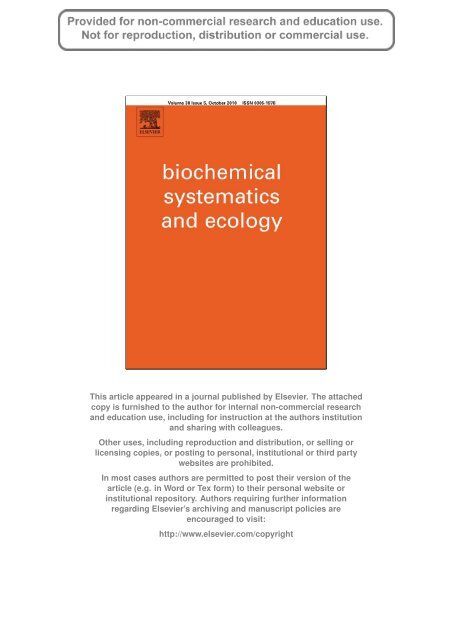


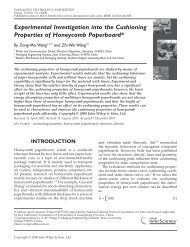
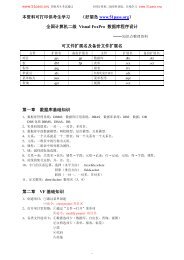
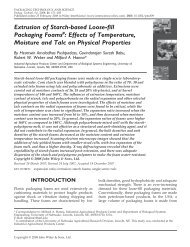
![()] 1](https://img.yumpu.com/45117883/1/190x143/-1.jpg?quality=85)

